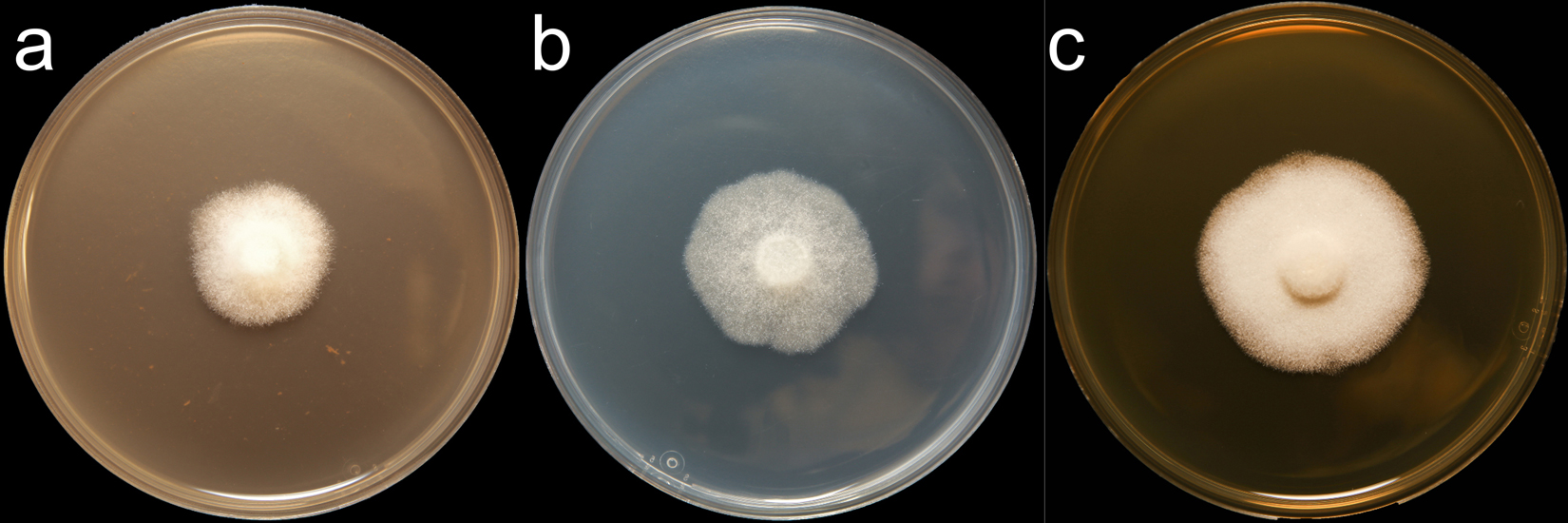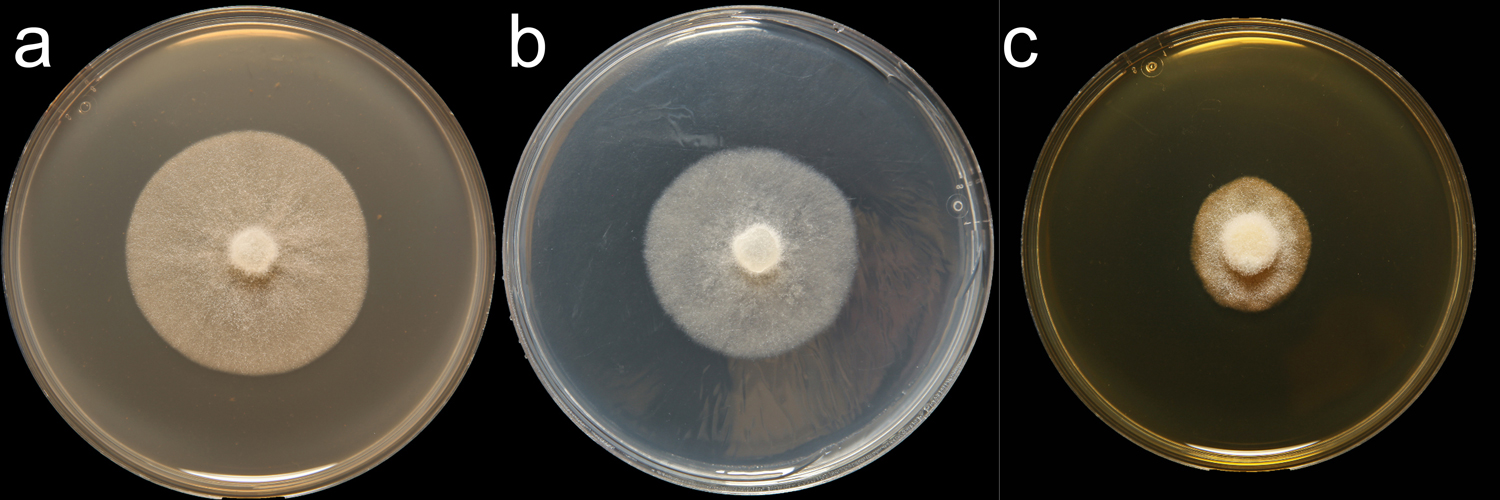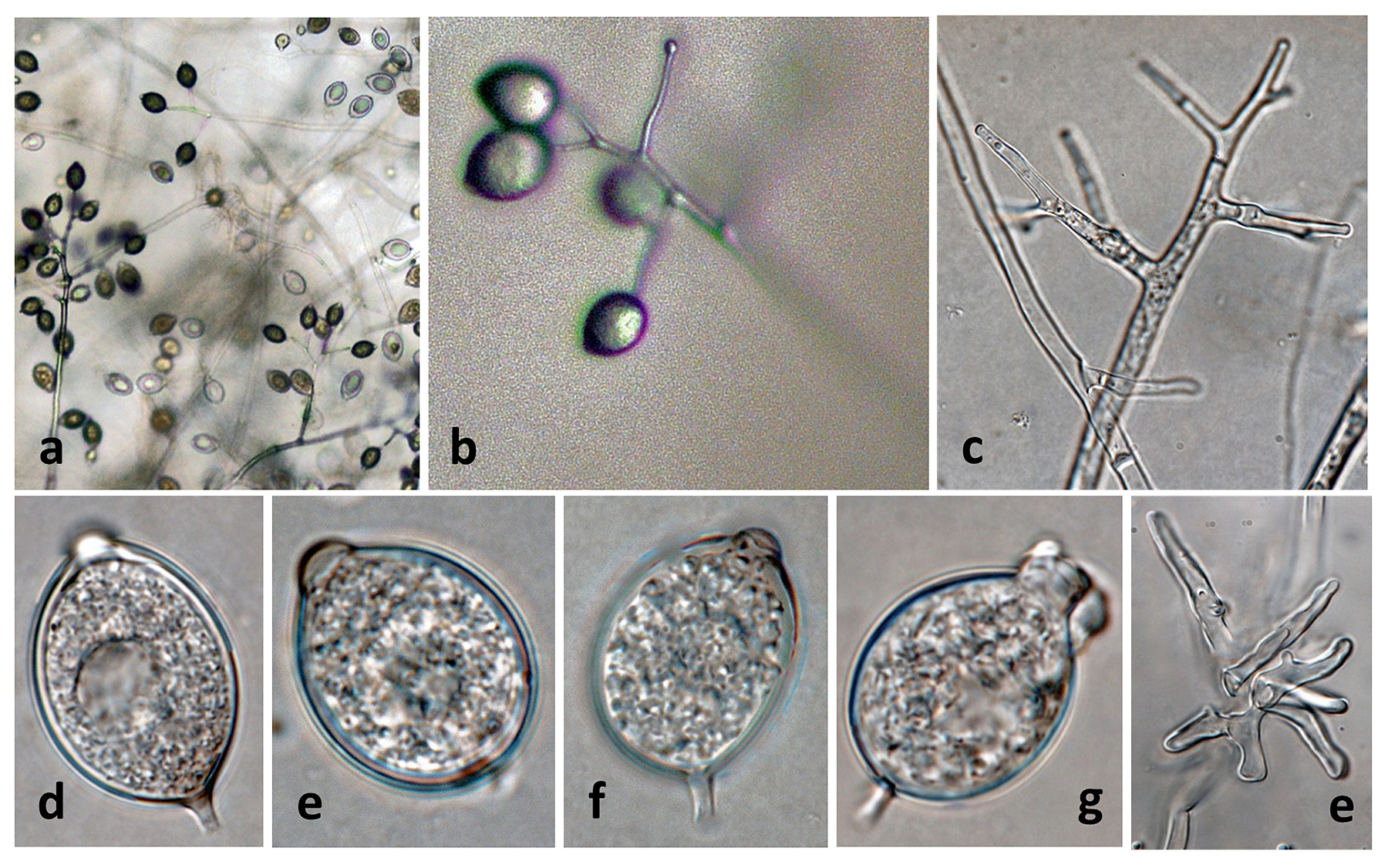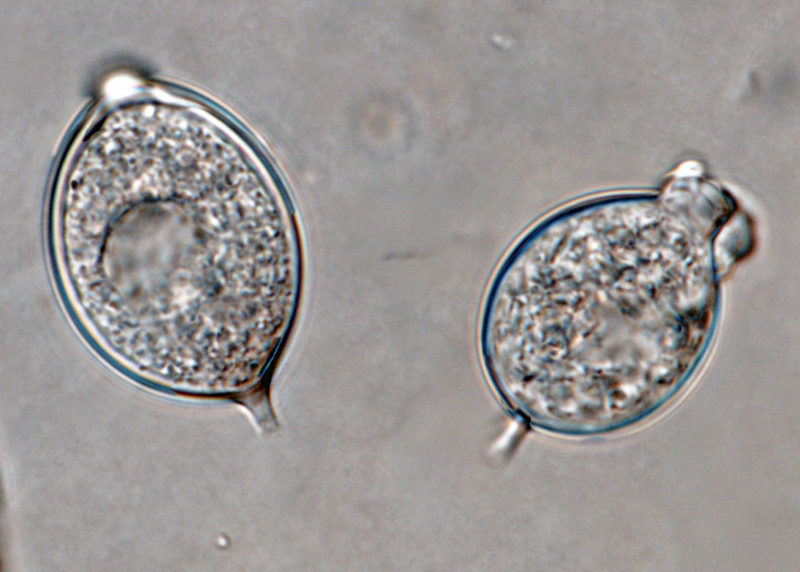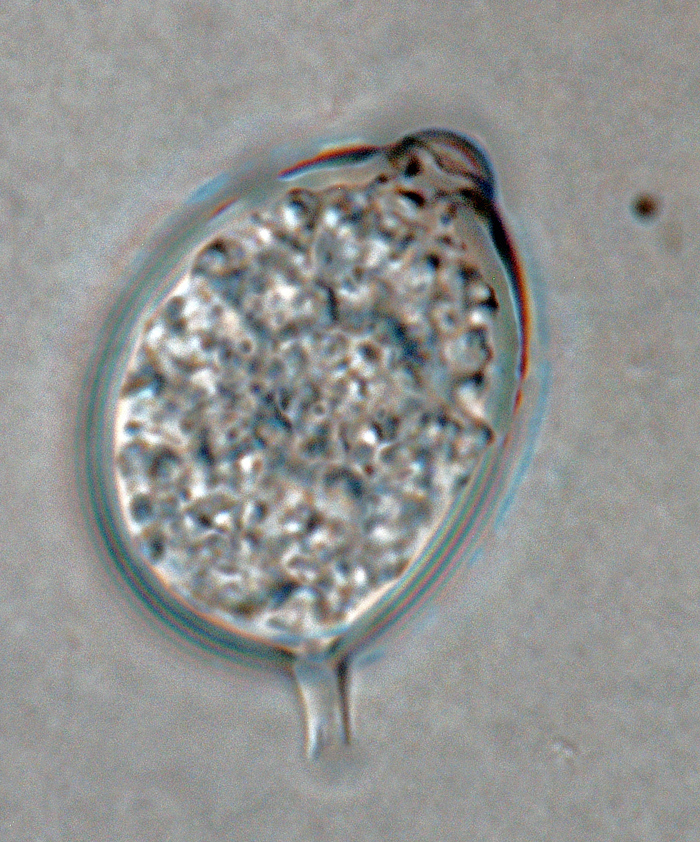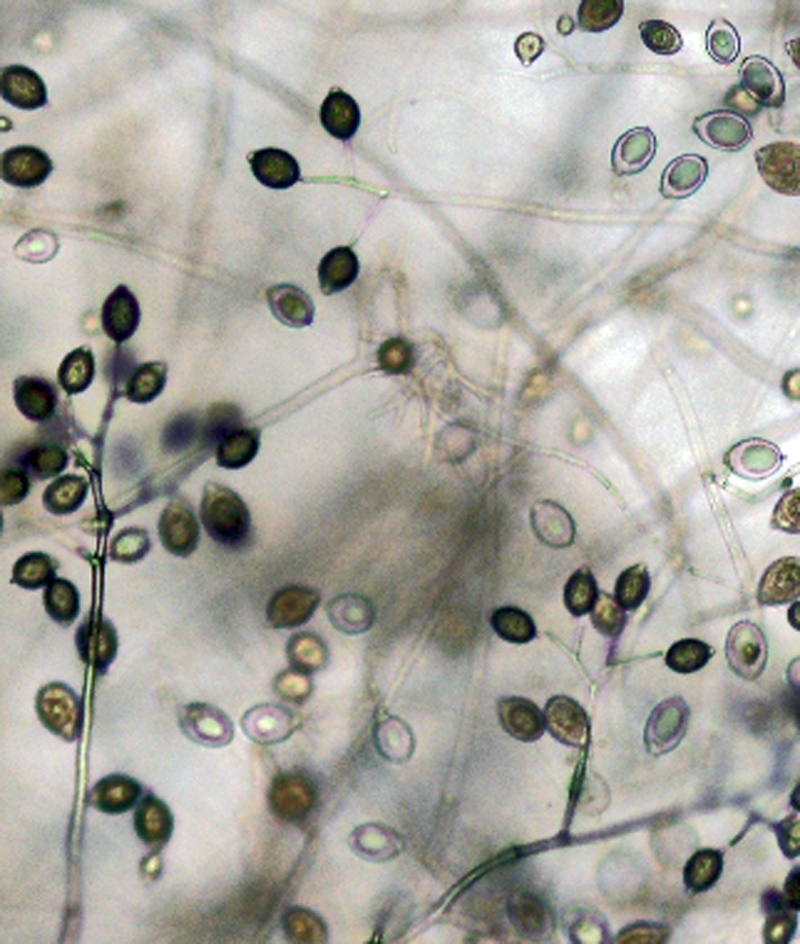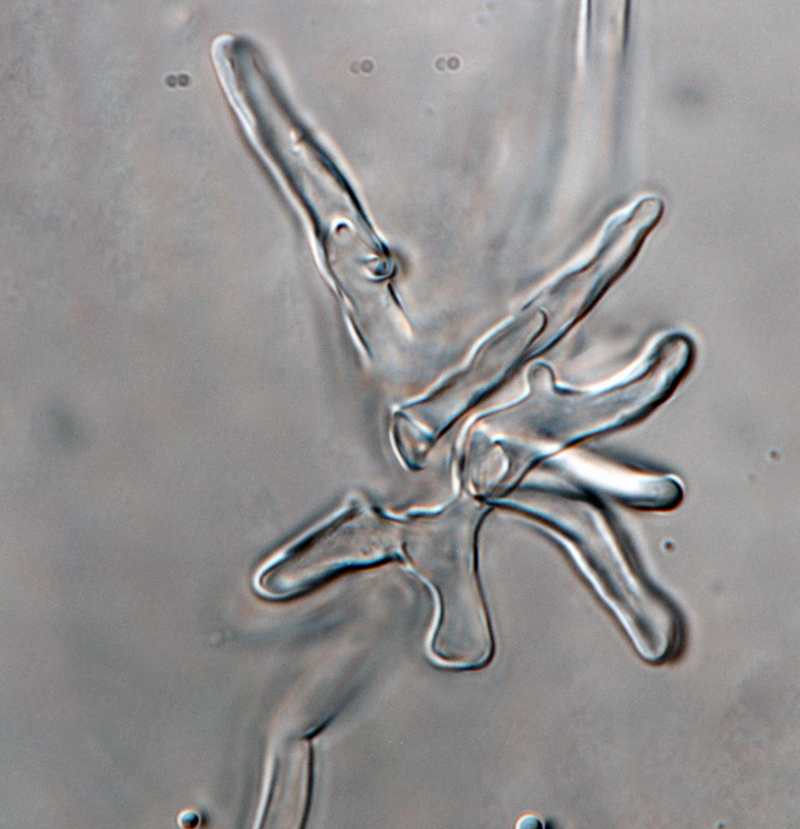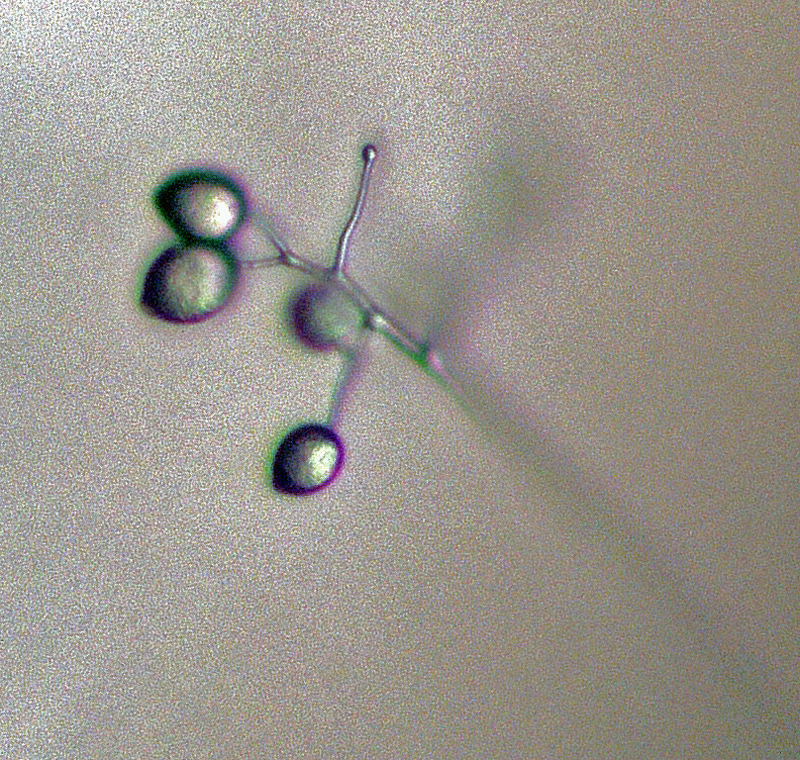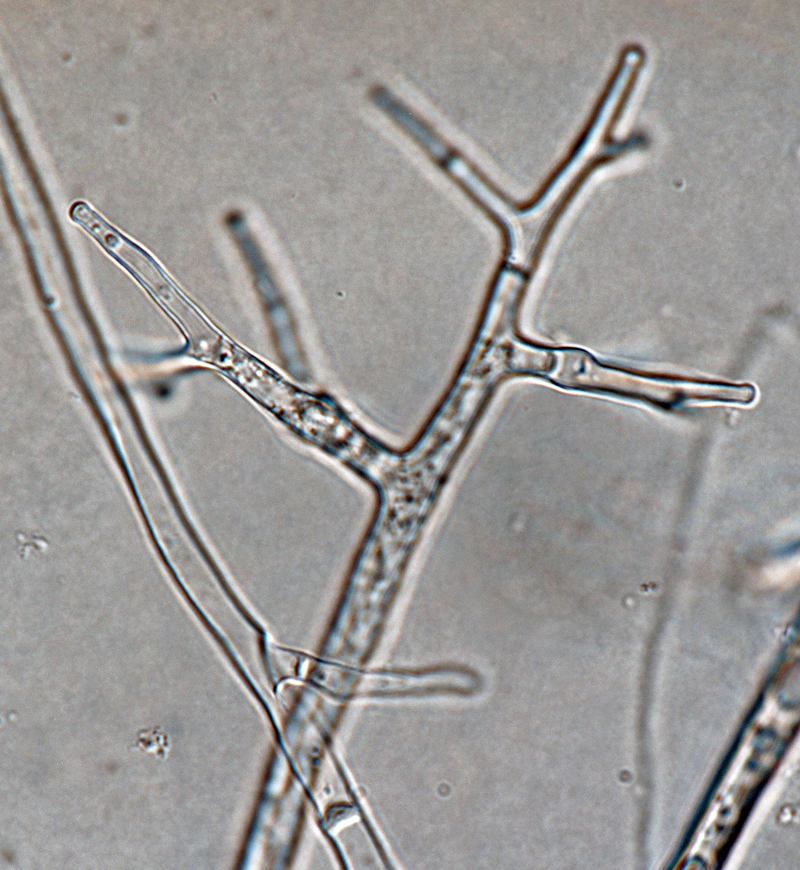Phytophthora litchii (in progress - Abad et al. 2023b)
|
Phytophthora spp. in Clade 4: portion of the seven-loci ML phylogeny featuring the type cultures of 212 described species (by T. Bourret). Notice the position of P. litchii Ex-neotype CBS 100.81 = S&T BL 48G. Gloria Abad, USDA S&T.
|
|
Phytophthora spp. in Clade 4: Morphological Tabular key (PDF) and Tabular key legends (PDF) in IDphy2 KEY SECTION. Notice the data of P. litchii Ex-neotype CBS 100.81 = S&T BL 48G. Gloria Abad, USDA S&T.
|
|
Phytophthora litchii (CPHST BL 48G) colonies of a selected specimen grown for 7 days on (a) V8® Agar, (b) potato dextrose agar, and (c) malt extract agar; photo by Krysta Jennings and Leandra Knight, USDA-APHIS-PPQ |
|
Phytophthora litchii (CPHST BL 145) colonies of a selected specimen grown for 7 days on (a) V8 Agar, (b) potato dextrose agar, and (c) malt extract agar; photo by Clinton Greub, Krysta Jennings and Leandra Knight, USDA-APHIS-PPQ |
|
Phytophthora litchii (CPHST BL 48G) asexual phase: (a-c) sporangiophores, (c) downy-mildew-like erected sporangiophores, (d-g) papillated sporangia, (e) finger-like hyphal swellings; photos by Gloria Abad, USDA-APHIS-PPQ. |
|
Phytophthora litchii (CPHST BL 48G) asexual phase: papillate caducous sporangia with short pedicels; photos by Gloria Abad, USDA-APHIS-PPQ. |
|
Phytophthora litchii (CPHST BL 48G) asexual phase: papillate caducous sporangium with short pedicel; photos by Gloria Abad, USDA-APHIS-PPQ. |
|
Phytophthora litchii (CPHST BL 48G) asexual phase: papillate caducous sporangium; photo by Gloria Abad, USDA-APHIS-PPQ. |
|
Phytophthora litchi (CPHST BL 48G) asexual phase: sporangia in compound sympodial sporangiophores; photo by Gloria Abad, USDA-APHIS-PPQ. |
|
Phytophthora litchii (CPHST BL 48G) asexual phase: finger-like hyphal swellings; photo by Gloria Abad, USDA-APHIS-PPQ. |
|
Phytophthora litchi (CPHST BL 48G) asexual phase: sporangia in compound sympodial sporangiophores; photo by Gloria Abad, USDA-APHIS-PPQ. |
|
Phytophthora litchi (CPHST BL 48G) asexual phase: downy-mildew-like erected sporangiophores; photo by Gloria Abad, USDA-APHIS-PPQ. |
Name and publication
Phytophthora litchii (C.C. Chen ex W.H. Ko, H.S. Chang, H.J. Su, C.C. Chen & L.S. Leu) Voglmayr, Göker, Riethm. & Oberw. (2007)
Göker M, Voglmayr H, Riethmüller A, and Oberwinkler F. 2007. How do obligate parasites evolve? A multi-gene phylogenetic analysis of downy mildews. Fungal Genet. Biol. 44: 105–122.
Basionym: Peronophythora litchii C.C. Chen ex W.H. Ko, H.S. Chang, H.J. Su, C.C. Chen & L.S. Leu 1978 (Index Fungorum)
Nomenclature
from Göker et al. (2007)
Mycobank
Synonymy
≡ Peronophythora litchii C.C. Chen ex W.H. Ko, H.S. Chang, H.J. Su, C.C. Chen & L.S. Leu, Mycologia 70: 381 (1978) [MB344384]
≡ Phytophthora litchii (C.C. Chen ex W.H. Ko, H.S. Chang, H.J. Su, C.C. Chen & L.S. Leu) P.K. Chi, X.P. Pang & R. Liu (1981) [MB532800]
Typification
Neotype: TAIWAN, from diseased litchi (Litchi chinensis Sonn.) fruits in Taiwan, TAI 4800 (dried dead culture) deposited at Herbarium of Department of Botany, National Taiwan University, Taiepei, Taiwan (from Ko et al. 1978)
Ex-neotype: ATCC 34595 (from Ko et al. 1978)
NOTE: TAI 4800 and ATCC 34595 were deposited as the type and ex-type of Peronophythora litchii (Ko et al. 1978). It is not clear if this isolate exists at ATCC.
Selected specimen(s) by Gloria Abad:
CPHST BL 48G = P15218 (WPC)
CPHST BL 145 = P19950 (WPC)
Selected specimen(s) in other collections
(ENT) CBS 100.81, ATCC34595, WPC P15218, S&T BL 48G (Abad)
Molecular identification
Voucher sequences for barcoding genes (ITS rDNA and COI) of the ex-type (see Molecular protocols page)
Phytophthora litchii isolate CPHST BL 48G (= P15218 WPC) = ITS rDNA MG865525, COI MH136920
Phytophthora litchii isolate CPHST BL 145 (= P19950 WPC) = ITS rDNA MG865524, COI MH136919
Voucher sequences for Molecular Toolbox with seven genes (ITS, β-tub, COI, EF1α, HSP90, L10, and YPT1
(see Molecular protocols page) (In Progress)
Voucher sequences for Metabarcoding High-throughput Sequencing (HTS) Technologies [Molecular Operational Taxonomic Unit (MOTU)]
(see Molecular protocols page) (In Progress)
Sequences with multiple genes for ex-type in other sources
- NCBI: Phytophthora litchii CPHST BL 48G
- NCBI: Phytophthora litchii CPHST BL 145
- NCBI: Phytophthora litchii CBS 100.81
- EPPO-Q-bank: Phytophthora litchii CBS 100.81
- BOLDSYSTEMS: Phytophthora litchii (barcoding COI & ITS)
Position in multigenic phylogeny with 7 genes (ITS, β-tub, COI, EF1α, HSP90, L10, and YPT1)
Clade clade:
a taxonomic group of organisms classified together on the basis of homologous features traced to a common ancestor
4
Morphological identification
Colonies and cardinal temperatures
Colony colony:
assemblage of hyphae which usually develops form a single source and grows in a coordinated way
morphology after 7 days of growth on V8 agar, potato-dextrose agar and malt extract with no distinct pattern. Minimum temperature for growth is 12°C, optimum 27–28°C, and maximum 30°C.
Conditions for growth and sporulation
Sporangia readily produced in V-8 agar flooded with 10% soil solution. OosporesOospores:
zygote or thick-walled spore that forms within the oogonium after fertilization by the antheridium; may be long-lived
rarely produced in culture media, except in hemp seed agar with fatty acids. Phytophthora litchii can easily grow in culture media like many species of Phytophthora.
Asexual phase
SporangiaSporangia:
sac within which zoospores form, especially when water is cooled to about 10°C below ambient temperature; in solid substrates, sporangia usually germinate by germ tubes
papillatepapillate:
pertaining to the production of a distinct papilla at the distal end of the sporangium (cf. nonpapillate and semipapillate)
; caducouscaducous:
pertaining to sporangia that become dislodged readily (i.e. deciduous) and separate from the sporangiophore (cf. persistent)
with short pedicelpedicel:
the hyphal base of a sporangium that remains attached after the sporangium separates, or is shed, from the sporangiophore; the pedicel may be short (< 5 µm), medium (5–20 µm), or long (> 20 µm)
; globoseglobose:
having a rounded form resembling that of a sphere
, ovoidovoid:
egg-shaped, with the widest part at the base of the sporangium and the narrow part at the apex
, ellipsoidellipsoid:
refers to a solid body that forms an ellipse in the longitudinal plane and a circle in cross section; many fungal spores are ellipsoidal or elliptic
(20–33 L x 16–22 W µm), produced in typical compound sympodial erected sporangiophores that resemble those produced in downy mildews. Hyphal swellings with finger-like shape. ChlamydosporesChlamydospores:
an asexual spore with a thickened inner wall that is delimited from the mycelium by a septum; may be terminal or intercalary, and survives for long periods in soil
absent.
Sexual phase
Sterile/homothallic. OogoniaOogonia:
the female gametangium in which the oospore forms after fertilization by the antheridium
smooth-walled, globoseglobose:
having a rounded form resembling that of a sphere
to ovoidovoid:
egg-shaped, with the widest part at the base of the sporangium and the narrow part at the apex
(25–33 L x 22–28 W µm); antheridiaantheridia:
the male gametangium; a multinucleate, swollen hyphal tip affixed firmly to the wall of the female gametangium (the oogonium)
amphigynousamphigynous:
pertaining to the sexual stage in which the antheridium completely surrounds the stalk of the oogonium (cf. paragynous)
; oosporesoospores:
zygote or thick-walled spore that forms within the oogonium after fertilization by the antheridium; may be long-lived
(18–21 µm diam.).
Most typical characters
Phytophthora litchii is characterized by the production of typical compound sympodial erected sporangiophores that resemble those produced in downy mildews.
Specimen(s) evaluated
Phytophthora litchii CPHST BL 48G, duplicate of P15218 (World Phytophthora Collection) (selected specimen)
CPHST BL 145, duplicate of P19950 (World Phytophthora Collection)
Hosts and distribution
Distribution: Asia, Europe (Netherlands)
Disease note: blossom blight
Host: Litchi chinensis (Sapindaceae)
Retrieved January 31, 2018 from U.S. National Fungus Collections Nomenclature Database.
Additional info
Substrate: fruits
Additional references and links
- SMML USDA-ARS: Phytophthora litchii
- EPPO Global Database: Phytophthora lilii
- Forest Phytophthoras of the world: Phytophthora lilii
- CABI Digital Library: Phytophthora lilii
- Encyclopedia of Life (EOL): Phytophthora litchii
- Index Fungorum (IF): Phytophthora litchii
- Google All Phytophthora litchii
- Google Images Phytophthora litchii
- Google Scholar Phytophthora litchii
Fact sheet author
Z. Gloria Abad, Ph.D., USDA-APHIS-PPQ-S&T Plant Pathogen Confirmatory Diagnostics Laboratory (PPCDL), United States of America.

